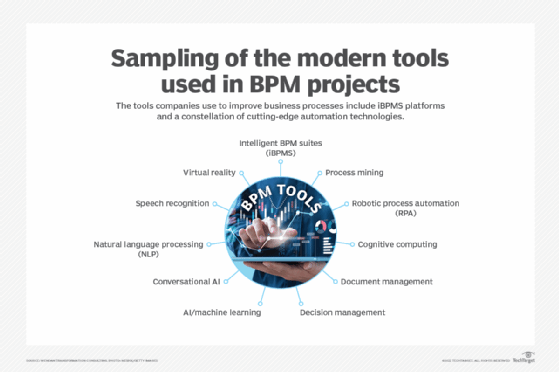BPO vs. BPM: What is the difference?
BPO and BPM both aim to improve business processes. One is a management approach to optimizing end-to-end processes. The other is a strategy used to improve specific processes.
Well-run organizations function by following business processes -- that is, a series of interconnected activities or steps designed to accomplish a specific business objective or output.
Hiring a new employee, for example, entails a series of steps ranging from developing a job requisition and scheduling interviews to onboarding the new employee into the organization.
How well an organization's business processes work determine the organization's overall success, explained Chad Anderson, assistant professor of information systems and analytics at Miami University's Farmer School of Business.
"All organizations function through business processes; therefore, an organization's effectiveness and efficiency are products of their business processes' effectiveness and efficiency," he said.
As such, executives spend significant amounts of time looking for opportunities to improve the processes within their business.
Business process management, or BPM, and business process outsourcing, or BPO, are two practices they use to improve and optimize their business processes.
What is BPM?
Business process management involves both the examination of an organization's end-to-end business processes to evaluate their effectiveness and to identify ways to improve them as well as the ongoing management of these processes.
 Chad Anderson
Chad Anderson
BPM analysis typically starts by capturing all the decision-making, activities and steps that make up a process as well as the flow of those elements.
Organizations can use various methodologies, such as Six Sigma, as well as BPM software products to enable and support this analysis.
Furthermore, organizations typically have multiple options for business process improvement, such as automating one or more steps within the process, eliminating steps and/or redesigning the entire process itself.
Various reasons could prompt an organization to undertake this analysis. There could be quality issues with the output of the business process, for example, or there could be concerns about the cost or time required to perform the process.
However, well-run organizations incorporate business process management into their leadership team's responsibilities; as such, leadership undertakes process analysis and improvement as a routine activity.
In such organizations, BPM runs on a loop: Leaders will undertake an analysis, implement improvements and then monitor those changes to ensure they produce the desired outcome before starting those steps all over again.

What is BPO?
Business process outsourcing is the use of a service provider to perform an organization's process.
"The full delegation of a specific set of tasks to an external party to perform," explained Mark Leverette, a partner in the advisory practice at BPM, a firm providing accounting, audit and advisory services.
 Mark Leverette
Mark Leverette
"BPO delivers a complete set of people and technology to accomplish that, and it could completely replace a segment of a business that would otherwise be performed by a group," he said, "or it could replace a business function [and all the processes it performs] that would otherwise be in-house within the company."
There are many reasons for an organization to outsource a business process to a service provider. An organization could determine that the service provider can perform the process at a lower cost, with better, faster and more accurate results -- or provide improvements on all these fronts.
An organization may also determine that it doesn't have and can't hire people with the expertise or skills required to perform the process.
Or an organization could determine it doesn't have and can't get the resources required to consistently perform a process to industry standards, accepted best practices or requirements set by government regulations.
Organizations typically outsource non-core processes that exist in most businesses, such as payroll, accounting and basic information technology services. Executives typically see lower risks to outsourcing such processes, as they are not proprietary to their business nor do they set their business apart in the market.
Organizations also opt to outsource processes that are specific to their industry but do not differentiate them in their sector; for example, healthcare providers often hire companies that specialize in medical billing, opting to outsource this function because those specialized service providers are experts in using the complex codes required by insurance companies.
In a typical arrangement, an organization contracts with a service provider to execute the business process at a negotiated price and to agreed-upon standards.
The organization can decide to hire a service provider that uses workers and facilities within the same country as the organization -- a specific outsourcing arrangement sometimes called "onshoring."
Or the organization can contract with a service provider who uses workers and facilities in another country; this outsourcing arrangement is often referred to as "offshoring." Many organizations opt for offshoring to save costs, as service providers choose locations with lower labor costs. However, some organizations also decide to offshore to support a follow-the-sun model by creating a global workflow that passes work between offices in different regions to increase responsiveness and overall efficiency.
BPM vs. BPO in a nutshell
1. Scope
BPM is a management approach to optimizing the end-to-end business processes within an organization. It includes designing, modeling, implementing, monitoring, optimizing and, if necessary, reengineering processes.
BPO is narrower in scope as it involves contracting out specific business processes or functions to a third-party provider, typically after the organization has assessed the value of outsourcing said processes.
2. Ownership
The ownership of BPM rests with the organization, directed by its internal teams focused on process improvement and optimization.
BPO providers are given ownership of the specific business processes an organization has decided to make them responsible for.
3. Automation
BPM involves the use of automation tools and technologies to improve efficiency, effectiveness, accuracy and speed of the activities that comprise a business process.
BPO providers also use automation technologies, but their use depends on the specific processes the provider is asked to handle. Some organizations will engage a BPO provider specifically for its superior automation capabilities.
4. Operational efficiency, cost optimization
BPM aims to improve the efficiency and cost-effectiveness of an organization's operations through the holistic management of its processes.
BPO providers are typically engaged specifically for their ability to reduce costs through economies of scale, specialized expertise and labor arbitrage.
BPM vs. BPO: Differences and similarities
There are many overlaps between BPM and BPO.
First, organizations frequently determine whether outsourcing a business process would be beneficial when they evaluate the process as part of their BPM activities.
Additionally, the BPM activities usually identify any downsides or challenges to outsourcing a process, such as whether the organization will have a hard time handing off the process to a service provider or whether it will need to reconfigure computer systems to send work to the service provider.
Service providers also have a role in business process management, as organizations can outsource BPM responsibilities to service providers.
In one instance of this, an organization hires an outside company -- often a consulting firm -- to perform the business process management activities, with the outside firm evaluating how well the organization executes on its processes and advising it on ways to improve them.
Or an organization can negotiate with its outsourced service provider to bring that same evaluation to the outsourced processes. This is sometimes called business process services. BPS involves the service provider performing the ongoing management, improvement and optimization of an enterprise process through redesign and/or technologies such as automation and intelligent process automation.
 Mark Voytek
Mark Voytek
Mark Voytek, chief advisor and a thought leader with the International Association of Outsourcing Professionals (IAOP), summarized the differences between BPO and business process management and services as follows:
"BPO involves contracting specific business operations to an external service provider. It's mainly used for cost reduction and efficiency improvement. BPS/M (Business Process Services/Management) refers to services that optimize and manage a company's business processes. It goes beyond mere outsourcing, and includes process improvement, technology implementation and managing complex business functions."
Mary K. Pratt is an award-winning freelance journalist with a focus on covering enterprise IT, cybersecurity management and strategy.






